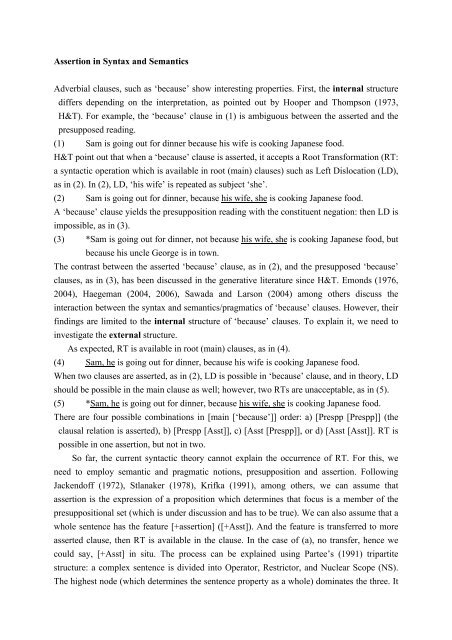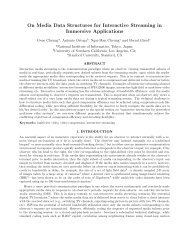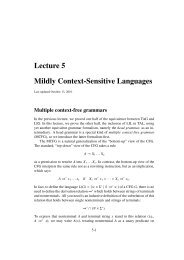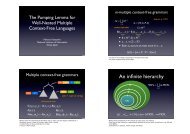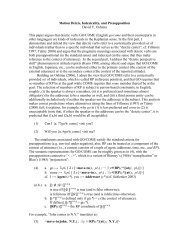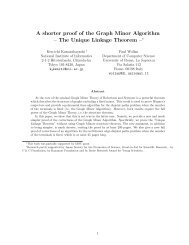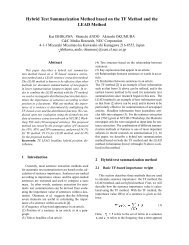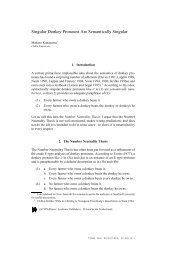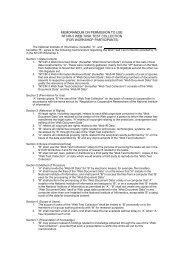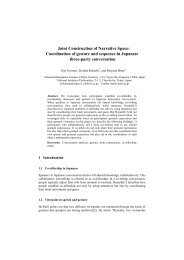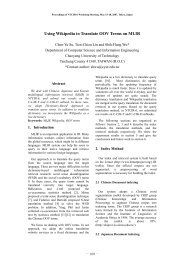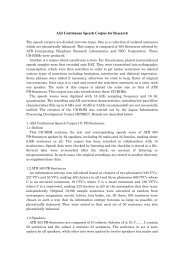Assertion in Syntax and Semantics Adverbial clauses, such as ...
Assertion in Syntax and Semantics Adverbial clauses, such as ...
Assertion in Syntax and Semantics Adverbial clauses, such as ...
Create successful ePaper yourself
Turn your PDF publications into a flip-book with our unique Google optimized e-Paper software.
<strong>Assertion</strong> <strong>in</strong> <strong>Syntax</strong> <strong>and</strong> <strong>Semantics</strong><strong>Adverbial</strong> <strong>clauses</strong>, <strong>such</strong> <strong>as</strong> ‘because’ show <strong>in</strong>terest<strong>in</strong>g properties. First, the <strong>in</strong>ternal structurediffers depend<strong>in</strong>g on the <strong>in</strong>terpretation, <strong>as</strong> po<strong>in</strong>ted out by Hooper <strong>and</strong> Thompson (1973,H&T). For example, the ‘because’ clause <strong>in</strong> (1) is ambiguous between the <strong>as</strong>serted <strong>and</strong> thepresupposed read<strong>in</strong>g.(1) Sam is go<strong>in</strong>g out for d<strong>in</strong>ner because his wife is cook<strong>in</strong>g Japanese food.H&T po<strong>in</strong>t out that when a ‘because’ clause is <strong>as</strong>serted, it accepts a Root Transformation (RT:a syntactic operation which is available <strong>in</strong> root (ma<strong>in</strong>) <strong>clauses</strong>) <strong>such</strong> <strong>as</strong> Left Dislocation (LD),<strong>as</strong> <strong>in</strong> (2). In (2), LD, ‘his wife’ is repeated <strong>as</strong> subject ‘she’.(2) Sam is go<strong>in</strong>g out for d<strong>in</strong>ner, because his wife, she is cook<strong>in</strong>g Japanese food.A ‘because’ clause yields the presupposition read<strong>in</strong>g with the constituent negation: then LD isimpossible, <strong>as</strong> <strong>in</strong> (3).(3) *Sam is go<strong>in</strong>g out for d<strong>in</strong>ner, not because his wife, she is cook<strong>in</strong>g Japanese food, butbecause his uncle George is <strong>in</strong> town.The contr<strong>as</strong>t between the <strong>as</strong>serted ‘because’ clause, <strong>as</strong> <strong>in</strong> (2), <strong>and</strong> the presupposed ‘because’<strong>clauses</strong>, <strong>as</strong> <strong>in</strong> (3), h<strong>as</strong> been discussed <strong>in</strong> the generative literature s<strong>in</strong>ce H&T. Emonds (1976,2004), Haegeman (2004, 2006), Sawada <strong>and</strong> Larson (2004) among others discuss the<strong>in</strong>teraction between the syntax <strong>and</strong> semantics/pragmatics of ‘because’ <strong>clauses</strong>. However, theirf<strong>in</strong>d<strong>in</strong>gs are limited to the <strong>in</strong>ternal structure of ‘because’ <strong>clauses</strong>. To expla<strong>in</strong> it, we need to<strong>in</strong>vestigate the external structure.As expected, RT is available <strong>in</strong> root (ma<strong>in</strong>) <strong>clauses</strong>, <strong>as</strong> <strong>in</strong> (4).(4) Sam, he is go<strong>in</strong>g out for d<strong>in</strong>ner, because his wife is cook<strong>in</strong>g Japanese food.When two <strong>clauses</strong> are <strong>as</strong>serted, <strong>as</strong> <strong>in</strong> (2), LD is possible <strong>in</strong> ‘because’ clause, <strong>and</strong> <strong>in</strong> theory, LDshould be possible <strong>in</strong> the ma<strong>in</strong> clause <strong>as</strong> well; however, two RTs are unacceptable, <strong>as</strong> <strong>in</strong> (5).(5) *Sam, he is go<strong>in</strong>g out for d<strong>in</strong>ner, because his wife, she is cook<strong>in</strong>g Japanese food.There are four possible comb<strong>in</strong>ations <strong>in</strong> [ma<strong>in</strong> [‘because’]] order: a) [Prespp [Prespp]] (theclausal relation is <strong>as</strong>serted), b) [Prespp [Asst]], c) [Asst [Prespp]], or d) [Asst [Asst]]. RT ispossible <strong>in</strong> one <strong>as</strong>sertion, but not <strong>in</strong> two.So far, the current syntactic theory cannot expla<strong>in</strong> the occurrence of RT. For this, weneed to employ semantic <strong>and</strong> pragmatic notions, presupposition <strong>and</strong> <strong>as</strong>sertion. Follow<strong>in</strong>gJackendoff (1972), Stlanaker (1978), Krifka (1991), among others, we can <strong>as</strong>sume that<strong>as</strong>sertion is the expression of a proposition which determ<strong>in</strong>es that focus is a member of thepresuppositional set (which is under discussion <strong>and</strong> h<strong>as</strong> to be true). We can also <strong>as</strong>sume that awhole sentence h<strong>as</strong> the feature [+<strong>as</strong>sertion] ([+Asst]). And the feature is transferred to more<strong>as</strong>serted clause, then RT is available <strong>in</strong> the clause. In the c<strong>as</strong>e of (a), no transfer, hence wecould say, [+Asst] <strong>in</strong> situ. The process can be expla<strong>in</strong>ed us<strong>in</strong>g Partee’s (1991) tripartitestructure: a complex sentence is divided <strong>in</strong>to Operator, Restrictor, <strong>and</strong> Nuclear Scope (NS).The highest node (which determ<strong>in</strong>es the sentence property <strong>as</strong> a whole) dom<strong>in</strong>ates the three. It
does not represent the surface word order, nor c-comm<strong>and</strong>, among the three. The structurerepresents the <strong>in</strong>terpretation of a sentence. Asserted clause falls <strong>in</strong>to NS. The availability ofRT is the feature transfer: the feature percolates down from the highest node to the clause <strong>in</strong>NS. It is like the feature <strong>in</strong>heritance from C to T under C-T probe (Chomsky 2004, 2007,2008). We <strong>as</strong>sume that top-down is more plausible than bottom-up (the compositionality) toexpla<strong>in</strong> the [+Asst] property of a clause.


